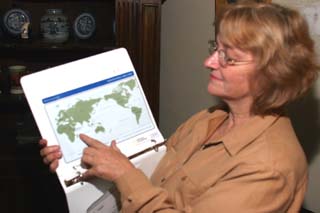
family tree Chili's Carole Thoms has always been interested and dedicated to history and genealogy. She's a member of the Chili Preservation Board and spends time restoring a circa 1825 family farm. So, when the opportunity arose through her employer, IBM, to participate in the National Geographic Society's Geographic Project, she was quick to volunteer. The Geographic Project aims to plot the migratory journey of humans descended from a common African ancestor who lived 150,000 years ago. By tracking DNA in populations around the world, project scientists like geneticist Spencer Wells, hope to discover the origins of ethnic groups and understand how populations of people moved across the planet. Carole Thoms didn't know what to expect when she submitted a DNA sample in August. IBM, a co-sponsor of the project, has more than 7,000 employees participating in the study. 60,000 people have joined in since the project began almost five years ago. Once Thoms' DNA was processed she was assigned a code and was able to track the analysis of her genetic information on-line as she was found to share genetic information with various groups and sub-groups with common ancestors. "The Geographic Project is not really a genetics project," says Dr. Spencer Wells. "It is using genetics as a tool to study history and anthropology." The project has taken on an urgency in Wells' view because of massive migrations currently in progress. "People are leaving their ancient homelands, moving to the cities and becoming part of the melting pot." According to the National Geographic Society, "A symptom of this mixing is the rapid decline in the number of spoken languages in the world. In the year 1500, linguists estimate 15,000 languages were spoken; today there are 6,000. "By the end of the century about half to 90 percent of those are going to be extinct," says Wells. By studying DNA from these ethnic groups, scientists hope to pinpoint when and where particular genetic changes happened, giving a clearer picture of how our ancestors migrated around the world. Ultimately it was determined that Thoms is part of "Haplogroup K," a group descended from "Mitochondrial Eve," the common ancestor of all living humans who lived in Africa some 150,000 years ago. Early members of this group moved into the eastern Mediterranean and what is now known as the Middle East before migrating, following retreating ice, northward into most of Europe. Tests have also revealed that Thoms' group is descended from Otzi, the Iceman, a 5,300 year old frozen Copper Age man found by hikers high in the Alps in 1991. "It's been a wonderfully interesting experience," Thoms says, "I've received a list of people who share common ancestors up to 150 generations ago. Several of these people have actually contacted me." For more information, to contribute to the scientific study, or to learn more about your ancestors and the human family tree, log on to: https://www3.nationalgeographic.com/genographic/index.html October 30, 2005 |
